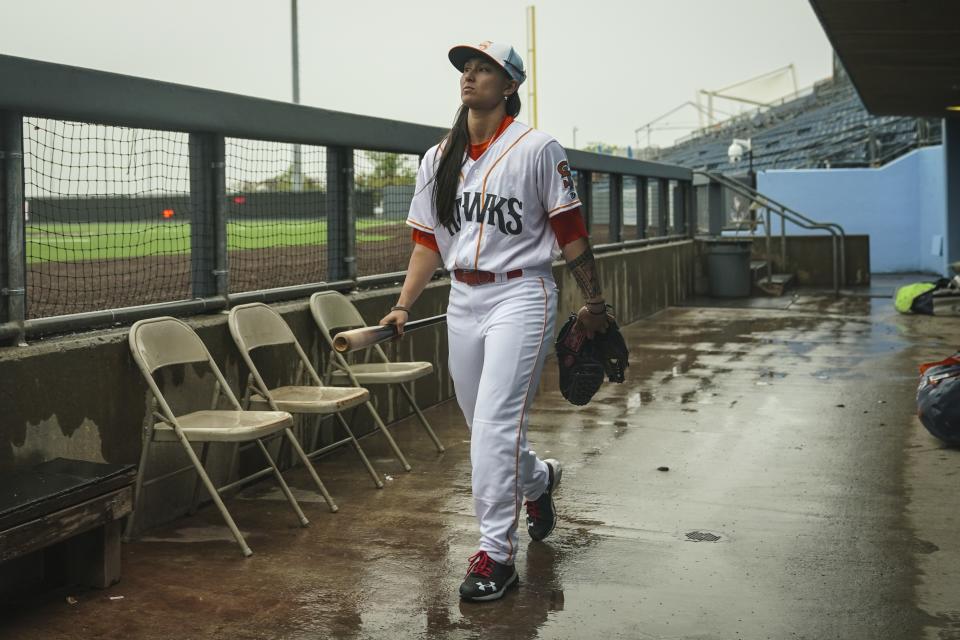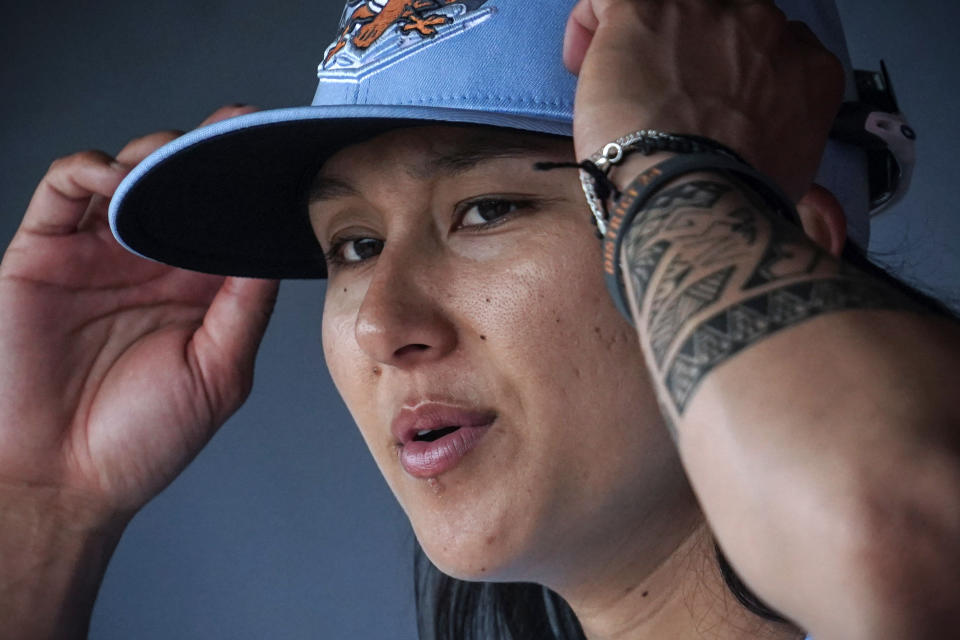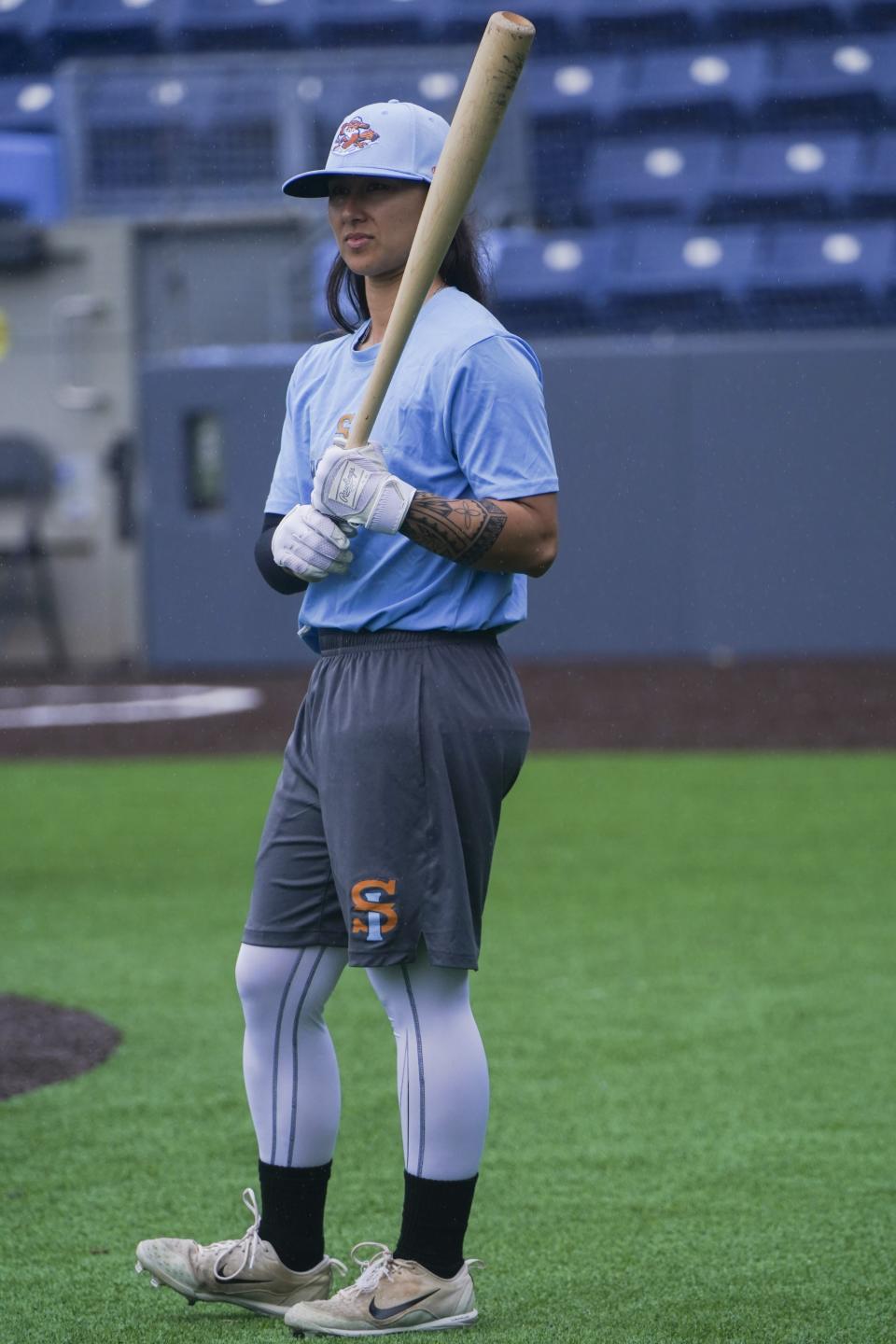Kelsie Whitmore & 'The Thing' take on the Atlantic League
NEW YORK (AP) — The first thing Atlantic League hitters notice about Kelsie Whitmore is the obvious: the Staten Island FerryHawks pitcher is the only woman in a league full of former major leaguers.
The surprises don't stop there. The next thing they're likely to see is a pretty big shocker, too.
“The Thing,” pitching coach Nelson Figueroa said with a smile. “It’s the weirdest thing I’ve ever seen.”
Whitmore joined the FerryHawks last month and made her debut April 21, becoming the first woman ever to play in the Atlantic League. The former college softball outfielder is a two-way player for Staten Island, competing at a level akin to Triple-A, making her the most advanced women's baseball player in decades. Her speed is an asset off the bench, and she’s connected at the plate off 93 mph fastballs, although she’s still seeking her first hit.
But the item in her scouting report most likely to help her compete with the men right now is The Thing, a pitch originating out of conversations with knuckleballers R.A. Dickey and Phil Niekro that morphed into a divebombing beast with the help of high-speed cameras and radar technology.
“It’s a knuckle-changeup,” Whitmore said. “I don’t try to get knuckleball movement out of it. I just want it to primarily get a lot of vertical break.”
Whereas knuckleball pitchers create unpredictable action on their pitches by eliminating spin altogether, The Thing comes out of Whitmore’s hand with just a little bit of top spin. She throws it as hard as she can, trying to get the pitch to look like a fastball at first. The rotations appears to slow as the pitch nears the plate, and that’s when the bottom falls out.
“It seems to just stop and then turn into a knuckleball,” Figueroa said.
The 5-foot-6 Whitmore won’t overpower hitters in any men’s pro league. Pitching in relief, her fastball currently tops out around 78 mph, and she and Figueroa are hoping she’ll tick up to 80 mph this season — still nearly 14 mph below the major league average.
Despite that, Figueroa and the FerryHawks think she can compete, and that's all she wants. The 24-year-old Whitmore has been at the forefront of women’s baseball since she was 14 and played for the U.S. women’s national team. She got her first major chance at competing with the men in 2016, when she and Stacy Piagno played for the Sonoma Stompers of the independent Pacific Association, a league well down the pro baseball ladder from the Atlantic League.
There is no pro women’s baseball league, and the Women’s Baseball World Cup is biennial. Whitmore has known for years that if she is going to live out her dream of playing ball every day, it will have to be against the men. And so she's been searching for a way to close the gap.
The quest briefly led her to the knuckleball, which she tried to learn with help from former pro Chris Nowlin. During that process, she exchanged messages with Dickey, the former Cy Young Award winner with the Mets, and also got advice from Niekro before the Hall of Famer died in 2020.
But then she changed her mind. She was desperate to turn pro, but fearful of becoming an oddity. She wanted to prove she could compete with a more conventional approach.
“I’m trying just to figure out how to get in this game,” she said. “But I don’t want to have to change who I am to try to get somewhere I want to be.”
Like so many aspiring pro pitchers these days, she turned to technology. With the help of ex-big leaguer Joe Beimel, she immersed herself in data from high-speed cameras and radar tracking, learning how small adjustments to her grip or motion could change the way the ball moved.
At one point, she showed Beimel the knuckleball grip, and he had an idea.
“He just said, ‘Why don’t you throw that hard as you can?’” Whitmore recalled.
And that's how The Thing took on its current form — a sinking offspeed pitch that looks something like a splitfinger fastball, the same pitch that turned closer Bruce Sutter into a Hall of Famer despite subpar velocity.
The Thing has piqued the interest of Staten Island teammates, including former All-Star Julio Teheran, who is only a year removed from being a major leaguer. He asked Whitmore to teach him the grip earlier this season.
It's inspired confidence for Whitmore, who was uneasy about how the pitch would be perceived. The first day she played catch with Figueroa, she initially refused to call the pitch anything other than a changeup.
“She says, ‘They think because I’m a girl, I’m throwing a knuckleball and it’s a gimmick,’” he recalled. “And I go, ‘No, it’s called nasty. That’s what it is. That’s your out pitch.’”
Staten Island brought Whitmore to spring training to see if she could compete. She faced 12 hitters during camp and allowed one hit, and she blew away Figueroa with her work ethic.
“If she was 6-foot-5 and 230 pounds, she'd be in the show,” he said.
Figueroa thinks the stuff can play, but Whitmore needs reps to figure out how to maximize it. She also throws a slider and a curveball, and she'll need to develop some guile in the way she mixes and matches those pitches.
“Pitching is being able to give a guy X, Y and Z when he’s expecting A, B and C, and she’s able to do that,” he said.
She got her first chance May 4, when manager Edgardo Alfonzo gave her the ball with the bases loaded, two outs and Staten Island trailing 3-1. She retired former big leaguer Ryan Jackson on four pitches with a fly out to right.
“I felt ready," she said. "I was a little nervous for it, just because it was a moment I’d been waiting for, to be able to get out there and compete.”
The FerryHawks don't see The Thing as a gimmick, nor Whitmore as an oddity, although Figueroa admits there was concern and uncertainty about how teammates would react.
“People didn’t even know what to say, like, ‘Atta girl?'" he said. "Is that offensive to her? And we literally sat down and asked her, you know, ‘What do you want us to say?’ And she’s like, ‘Call me anything. I’m one of the guys. Dude, whatever.’”
Figueroa has stopped worrying. He says Whitmore has earned the clubhouse's respect with her work ethic, focus and talent. Whitmore says gaining her teammates' respect was priority No. 1 coming in, and she's satisfied with how she's been treated.
“I think anywhere you go, you’re going to be a little scared of being used the wrong way," she said. "But sometimes you have to take chances and trust that they’ll have the right intentions and give you the opportunity for who you are as an athlete and as a player.
“I think it’s respecting what I do and respecting my goals of playing at the highest level possible.”
___
Follow Jake Seiner: https://twitter.com/Jake_Seiner
___
More AP MLB: https://apnews.com/hub/MLB and https://twitter.com/AP_Sports

 Yahoo Movies
Yahoo Movies 





